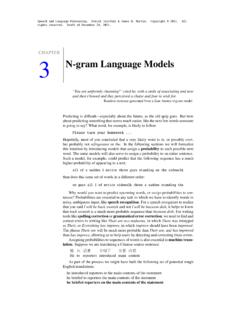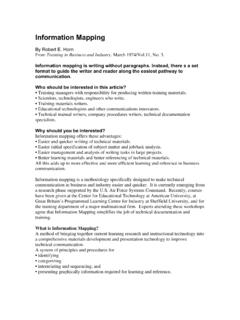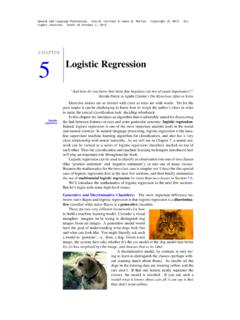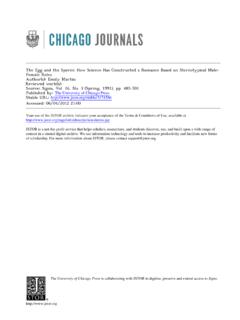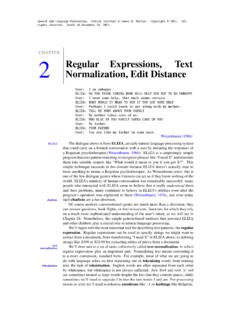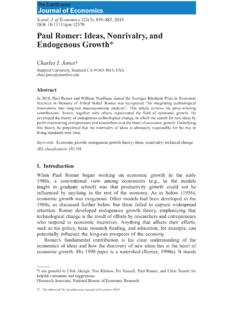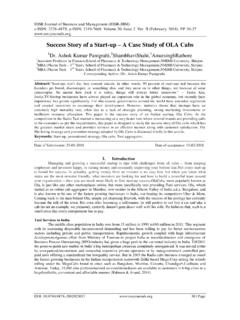Transcription of The Impact of Online Food Delivery Services on Restaurant ...
1 The Impact of Online Food Delivery Services on Restaurant SalesJack Collison Department of Economics, Stanford UniversityAdvised by Professor Liran EinavSpring, 2020 AbstractThe rapid growth of Online food Delivery Services has disrupted the traditionally offlinerestaurant industry. This study presents empirical evidence on the crowding-out effectsand market expansions induced by the staggered entry of Online food Delivery methodology reveals that 30-50 cents of every dollar spent ononline food Delivery Services are incremental, while the rest is drawn away from brick-and-mortar sales. These findings are statistically significant at the zip code-level andare heterogeneous across different types of consumption, suggesting that convenienceand pre-existing spending habits drive the level of substitution. Conducting analyseson a year-by-year basis suggests that there is an increasing level of cannibalization ofbrick-and-mortar Restaurant sales.
2 Back-of-the-envelope calculations show an increasein restaurants revenues but a decrease in :E-commerce, market expansion, sales cannibalization E-mail I am extremely grateful to my advisor, Professor Liran Einav,for his excellent guidance, input, and advice. I would like to thank Honors program director Marcelo Clerici-Arias and Sebasti an Otero for assisting me in the process of developing a thesis. I would also like to thankProfessor Pete Klenow, Ben Klopack, Toren Fronsdal, and the other faculty and graduate students who havegiven me feedback and advice. Finally, I would like to thank Suresh Vaidyanathan, Larry Levin, and allother members of Visa who have supported me. All errors are my Online Delivery is surging, and eating in is the new dining out. Online commerce reduced trafficin brick-and-mortar stores, which this year are closing at a record-setting Meal-deliverycompanies are a symbol of what might be the most powerful force in business today: conveniencemaximalism.
3 Derek Thompson,The Atlantic(2019)1 IntroductionThe meteoric growth of e-commerce makes it an ever-important area to study . Even intraditional industries, well-established offline firms have adopted new Online sales channelsthat aim to increase their revenue. This has led to the hybridization of strictly brick-and-mortar stores, which now operate both Online and offline. In fact, by 2012, more than 80percent of retailers sold merchandise through both Online and offline channels (Wang,Song, and Yang 2012). One of the most prolific applications of this recent hybridizationis in the Restaurant industry, with the emergence of Online food Delivery Services . Deliverytransactions made up six percent of total US Restaurant sales in 2017 and are estimated toreach 40 percent of all Restaurant sales by 2020 (Morgan Stanley Research 2017).
4 1 However,the extent to which these Online sales are incremental causing overall Restaurant sales toincrease or, alternatively, drawn away from brick-and-mortar sales, has not been food Delivery is a prime example of e-commerce disrupting a traditional market. Aflood of new food Delivery firms has caused rapid growth in the total number of transactionsand revenue for the nascent industry. Although Online food Delivery Services provide extrachannels for potential revenue, they also create the risk of cannibalization in which brick-and-mortar sales actually suffer because consumers who purchase in-store have transitionedto mostly Online purchasing behavior. The purpose of this study is to determine the effectsthat the entry of these firms and subsequent hybridization has had on Restaurant sales1 The COVID-19 pandemic may further accelerate this trend because in-person dining has essentially beenshut quantifying the levels of substitution between in-person Restaurant sales and Online fooddelivery staggered deployment and expansion of Online food Delivery Services across time andspace provides an opportunity to estimate these effects and how they vary across locationsand over time.
5 In order to do so, I use the universe of Visa Inc. s individual-level credit anddebit transactional data. Each observation in the main dataset is an individual transactionbetween a business (the merchant) and a consumer (a cardholder). On the merchant side,the name, zip code, and category of the business are recorded. On the cardholder side, onlythe anonymized card number is visible. Other variables of interest include the transactionamount and a record of how the purchase was conducted (a physical card swipe, onlinetransaction, phone charge, etc.). The data encapsulates all businesses at which cardholdersuse their Visa cards. In order to maintain a sample that is useful for the analysis, the data isrestricted to purchases that occurred at restaurants in the United States from 2014 through2017. Cardholder location and family status are imputed based on transactional analysis explores heterogeneity along these dimensions, as well as other factors of timeand primary empirical specification is a standard differences-in-differences with a contin-uous treatment variable.
6 I regress total dollars-per-card brick-and-mortar and Online fooddelivery service sales spent at restaurants on dollars-per-card spent on Online food deliveryservices with month and zip code fixed effects in order to quantify the level cannibalizationof Restaurant sales. If the two are uncorrelated, this suggests that every dollar spent ononline food Delivery service is cannibalized; if the two are perfectly correlated, this suggeststhat Online food Delivery Services are providing purely incremental sales to restaurants. Morespecifically, the coefficient on Online sales shows the fraction of each dollar spent on onlinefood Delivery Services that is new; the remainder is drawn away from brick-and-mortar find that roughly half of each dollar spent on Online food Delivery Services is new,whereas the remaining half is converted from in-person Restaurant sales.
7 This suggests that3online food Delivery Services provide modest incremental sales, but also draw away fromtraditional sales. Stratifying the regression by the time of transaction shows that while eachdollar spent on Online food Delivery Services during lunch, dinner, different seasons, and thework week provide some additional sales, Online food Delivery sales during the weekend aremostly cannibalized from brick-and-mortar sales. The differences in these estimates suggestthat convenience is an important factor in drawing consumers to Online food Delivery time constraints during the week, the ease of Online food Delivery Services maybe driving the higher level of substitution between Online and offline zip codes into quartiles of average monthly Restaurant expenditure showsthat the lower quartiles substitute only 10 percent every dollar spent on Online food deliveryservices, whereas the higher quartiles substitute up to half of every dollar spent on onlinefood Delivery Services .
8 This suggests that Online food Delivery Services are drawing in thosewho typically do not spend much at restaurants. The distinction of urban and rural regionsshows that rural areas provide almost completely new Restaurant sales via Online food deliveryservices; the region of the northern or southern states has little effect on the levelsof substitution. Finally, conducting a year-over-year analysis shows that the additional salesprovided by Online food Delivery Services are decreasing over time. This suggests that there isincremental cannibalization of brick-and-mortar Restaurant sales as exposure to Online fooddelivery Services increases. Further, back-of-the-envelope calculations show that restaurants revenues are increasing but their profitability is are many descriptive studies that document the growth of Online food Delivery ser-vices and the characteristics of the customers that use them (Morgan Stanley Research 2017;Technomic Food Trends 2018; Wirth 2018; Zion, Spangler, and Hollmann 2018).
9 However,these studies rely on self-reported qualitative surveys that were sent out to a few thou-sand individuals, which could potentially lead to selection bias, reporting inaccuracies, andattrition rates over time. The analysis presented in this study quantifies cannibalizationof traditional Restaurant sales by Online food Delivery Services using a large, representative4network of transactions. This not only contributes to a growing literature on substitutionbetween Online and offline sales channels by examining a new and growing industry, but alsoprovides some of the first empirical evidence on the Impact of Online food Delivery this study focuses on Online food Delivery Services , the results could potentiallybe extrapolated to different markets. Other traditional markets have many confoundingfactors such as a less transparent firm-entry pattern, which leads to difficulty in quantifyingthe effects of e-commerce.
10 Restaurants and Online food Delivery Services , however, lendthemselves well to studying these effects. While there might be other outside factors indifferent industries that Impact the causal effects of e-commerce, the lessons derived here arelikely similar rest of the paper is organized as follows. In Section 2 and Section 3, I providebackground on the evolution of Online food Delivery Services and literature related to Online -offline substitution. Section 4 introduces the data, the construction of key variables, andrelevant summary statistics. Section 5 and Section 6 describe the empirical strategy andresults, respectively. Section 7 concludes BackgroundOnline food Delivery Services have been around for quite some time. Several chain restau-rants created websites to order take-out, but these Services were limited to within the chain sown restaurants followed suit, creating their own websites for de-livery.
